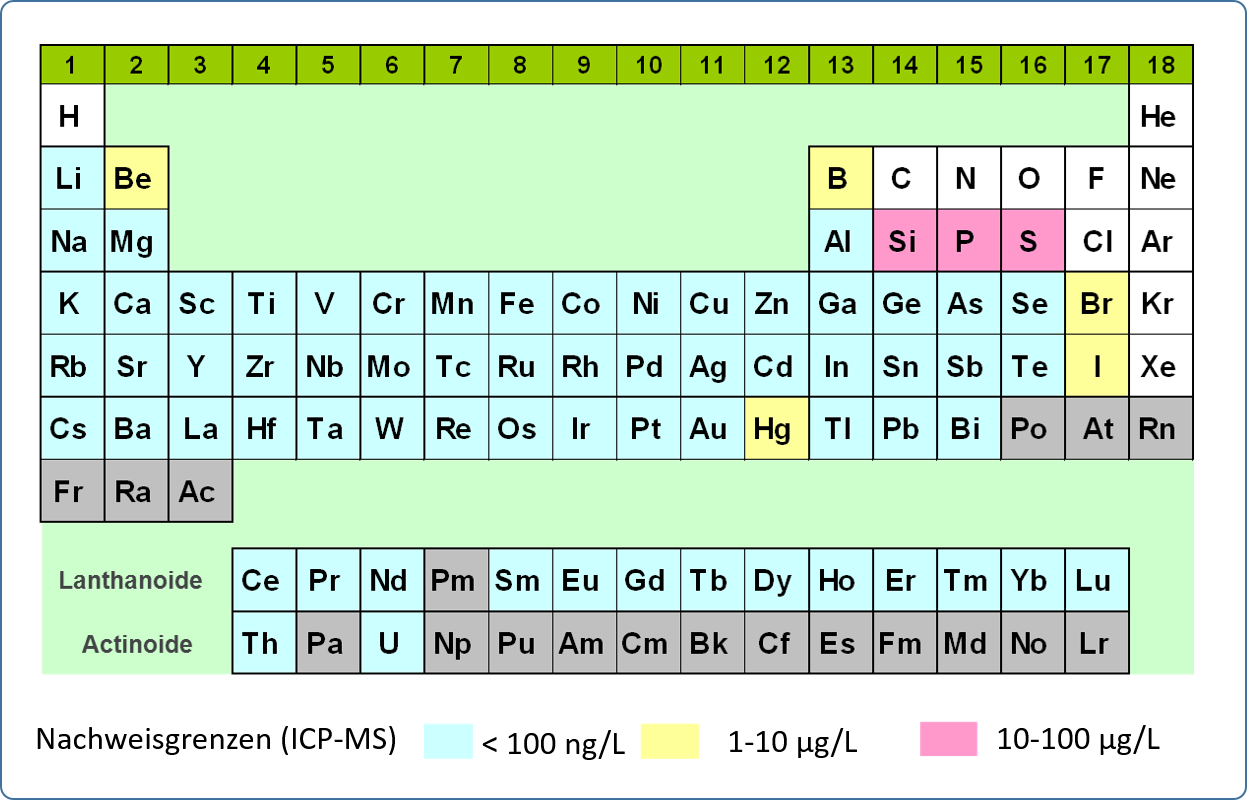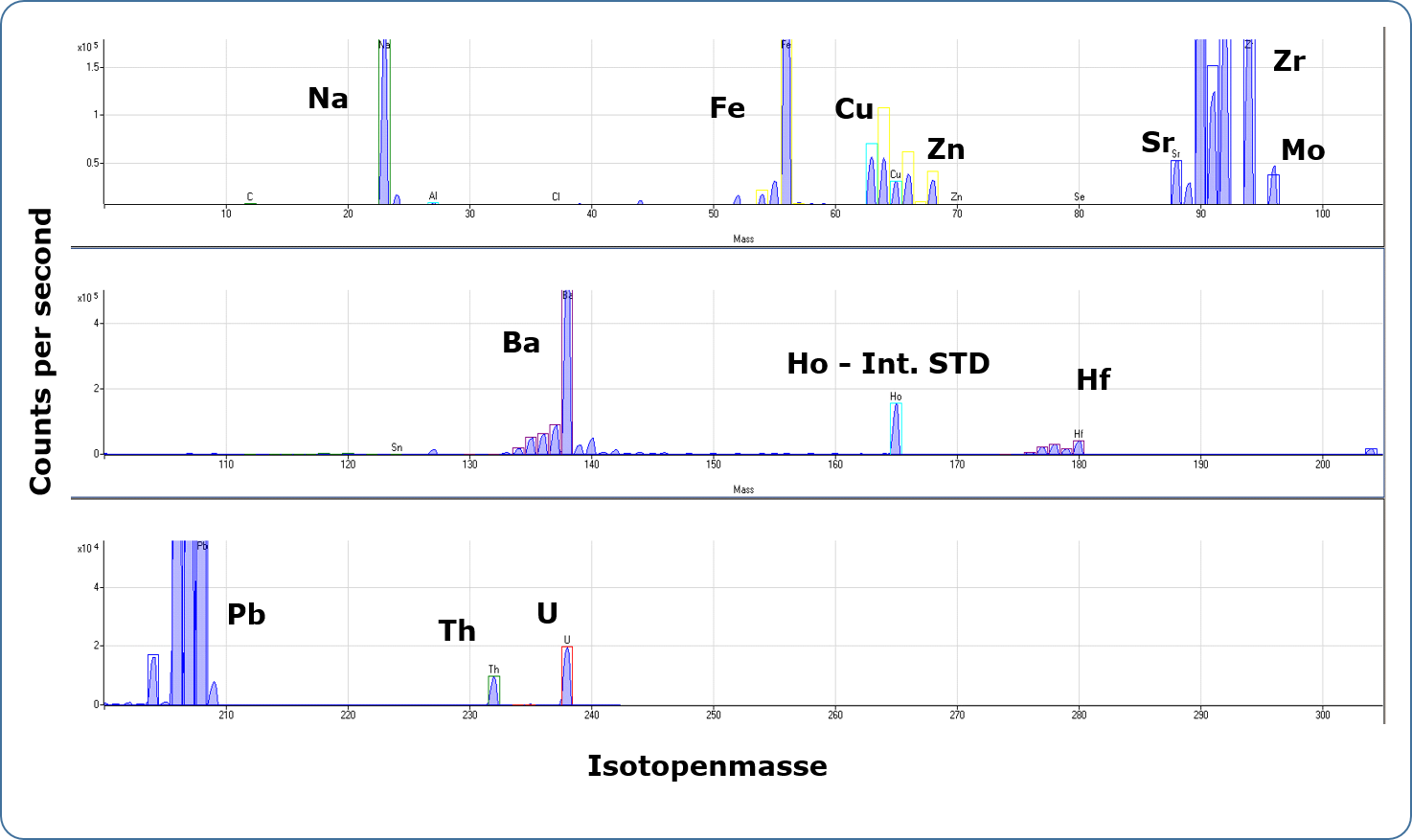Elementanalytik mit AAS, ICP-OES und ICP-MS
Multielementanalytik von wässrigen Proben mittels AAS, ICP-OES (Routineanalytik) bzw. ICP-MS (Spurenanalytik und Bestimmung von Element-Isotopenzusammensetzungen) im Rahmen der nicht-kommerziellen wissenschaftlichen Forschung.
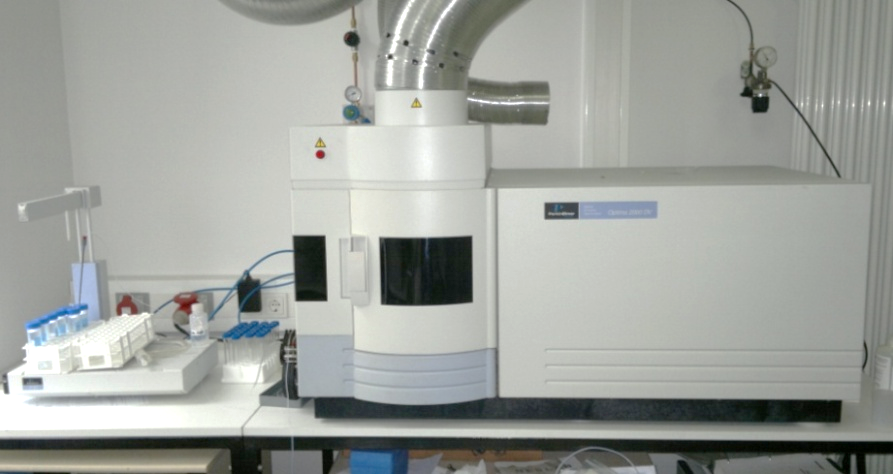
AAS und ICP-OES
Für die Routineanalytik von Elementen in wässrigen Lösungen im Konzentrationsbereich mg/L bis µg/L wird die Atom-Absorptionsspektroskopie (AAS) und die Optische Emissionsspektroskopie mit induktiv gekoppeltem Plasma (ICP-OES) eingesetzt. Die beiden Verfahren ermöglichen die quantitative Bestimmung fast aller Metalle und auch einiger Nichtmetalle (insgesamt bis zu 70 Elemente) aus angesäuerten, wässerigen Lösungen bis zu einem Gesamtgehalt an gelöster Substanz von ca. 1 g/L.
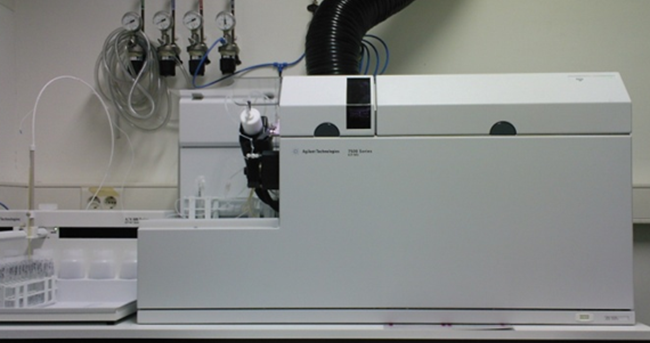
ICP-MS
Für die Analyse von Spurenelementen sowie der Isotopenzusammensetzung von Elementen in wässrigen Lösungen im Konzentrationsbereich µg/L bis ng/L wird die Massenspektrometrie mit induktiv gekoppeltem Plasma (ICP-MS) eingesetzt. Das Verfahren ermöglicht die gleichzeitige Bestimmung aller Metalle und einiger Nichtmetalle (bis zu 70 Elemente) aus angesäuerten, wässerigen Lösungen bis zu einem Gesamtgehalt an gelöster Substanz von ca. 1 g/L.

Bestimmbare Elemente
Mit diesen Messmethoden können etwa 70 Elemente bis zur Ordnungszahl 83 plus Th und U simultan gemessen werden. Nicht messbar sind C, N, O, Tc, Pm, die Halogene F und Cl und alle Edelgase.
Probenvorbereitung und Messprinzip
Probenentnahme und Probenvorbereitung:
Wässrige Proben werden mit einem 0,45 µm Filter filtriert und unmittelbar nach der Probenentnahme mit hochreiner, konzentrierter Salpetersäure auf 1-5 Vol.% angesäuert und in Probenflaschen aus inertem Kunststoff (PE, FEP oder PFA) aufbewahrt, um Elementverluste durch Ausfällung bzw. Adsorption am Gefäßmaterial auszuschließen. Die Proben können anschließend im Labor ohne weitere Aufbereitung direkt analysiert werden.
Messprinzip beim ICP-OES:
Bei der ICP-OES Analytik wird die Probenlösung über ein pneumatisches Zerstäubersystem in ein induktiv gekoppeltes Argonplasma eingebracht. Bei einer Temperatur von 6000-8000 K im Plasma werden die Elemente angeregt und ionisiert. Unter Abgabe einer elementspezifischen Strahlung (Wellenlänge) fallen diese dann wieder in ihren Grundzustand zurück, wobei die Wellenlänge (Auflösung im Bereich von 0,005 nm) der emittierten Strahlung elementspezifisch ist. Die quantitative Bestimmung erfolgt auf der Grundlage der Proportionalität von Strahlungsintensität und Elementkonzentration in Kalibrier- und Analyt-Lösungen. Dadurch lassen sich Analyten im mittleren Konzentrations- und Spurenbereich in wässrigen oder Aufschlusslösungen bestimmen.
Messprinzip beim ICP-MS:
Bei der ICP-MS Analytik wird die Probenlösung ebenfalls über ein pneumatisches Zerstäubersystem in ein induktiv gekoppeltes Argonplasma eingebracht. Bei einer Temperatur von 6000-8000 K im Plasma werden die Elemente angeregt und ionisiert. Der Ionisationsgrad vieler Elemente beträgt bei diesen Temperaturen mehr als 50%. Die vorliegenden einfach positiv geladenen Ionen gelangen durch zwei Lochblenden (Sampler und Skimmer cone) über ein elektrostatisches Linsensystem in das Hochvakuum des Quadrupol-Massenspektrometers. Durch eine vorgeschaltete Kollisionszelle können bei Bedarf störende Molekülionen abgetrennt werden. Im Quadrupol werden die Ionen bzw. Isotope nach ihrem Masse/Ladungs-Verhältnis aufgetrennt und mittels eines empfindlichen ladungssensitiven Detektors (dual mode SEV) nachgewiesen. Die Messsignale auf den einzelnen Isotopen-Massen (Element Lithium-6 bis Uran-238, Auflösung ca. 0,3 amu) werden sequentiell erfasst und mit einem Computer ausgewertet. Zur quantitativen Bestimmung des Elementgehalts einer Lösung wird das Gerät mit Standard-Lösungen bekannten Gehalts kalibriert.
Informationen zur Analyse von Metallen in wässrigen Lösungen mittels ICP-MS
Bei der Abgabe von Proben sollten folgende Dinge beachtet werden:
- Die filtrierten Proben sollten in wässriger, klarer Lösung vorliegen
- Der Kohlenstoffgehalt (organisch sowie anorganisch) sollte < 1% sein
- Die Proben sollten angesäuert sein, dabei bitte konzentrierte Salpetersäure
(65% HNO3; suprapure Reinheit oder vergleichbar) verwenden (kann zur Verfügung gestellt werden) - Als Probengefäße bitte saubere und trockene Plastikgefäße (s.o.) verwenden, Glasgefäße können zu verfälschten Ergebnissen führen auf Grund von Ausbluten diverser Kationen aus dem Glas
- Bitte einen Blank beifügen (enthält alles genau im selben Verhältnis wie die Probe, nur nicht die zu untersuchenden Analyten)
Beispiel Blank: Eine wässrige Waschlösung eines Messingbads (CuZn-Legierung) soll auf Kupfer und Zink untersucht werden.
- Die Probe enthält die Lösung nach dem Waschschritt inklusive der zugesetzten Salpetersäure.
- Der Blank enthält die Waschlösung vor dem Waschschritt inklusive der zugesetzten Salpetersäure.
Nur wenn beide Proben vorhanden sind, kann durch die Differenz die genaue Menge von Zink und Kupfer bestimmt werden, welche durch den Spülschritt herausgelöst wurden.
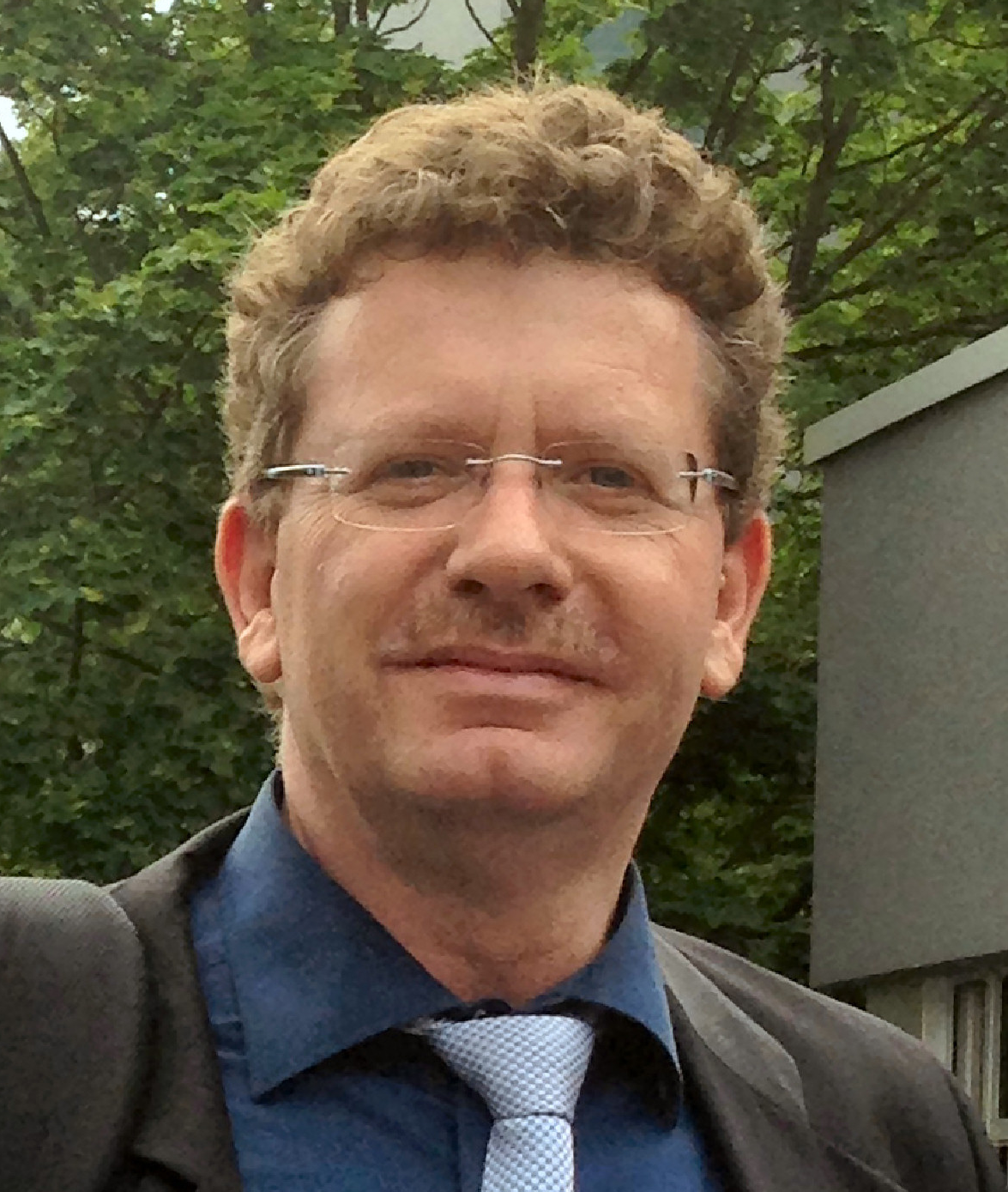
Anfrage und Kontakt
apl. Prof. Dr. Ralf Kautenburger
Universität des Saarlandes
Anorganische Chemie
Elementanalytik - WASTe
Campus C4 1, Raum -1.06
66123 Saarbrücken
Tel.: +49 681 302 2171
Fax.: +49 681 302 70655
E-mail: r.kautenburger(at)mx.uni-saarland.de
Auswahl an Publikationen mit ICP-MS-Daten
(peer reviewed)
WISSEL, K., HABEN, A., KÜSTER, K., STARKE, U., KAUTENBURGER, R., ENSINGER, W. AND CLEMENS, O. (2024) Direct Recycling of β-Li3PS4-Based All-Solid-State Li-Ion Batteries: Interactions of Electrode Materials and Electrolyte in a Dissolution-Based Separation Process. Adv. Energy Sustainability Res. 2300280.
https://doi.org/10.1002/aesr.202300280
BRIX, K., HABEN, A., KAUTENBURGER, R. (2023) Time-Dependent Retention of a Mixture of Cs(I), Sm(III), Eu(III) and U(VI) as Waste Cocktail by Calcium Silicate Hydrate (C-S-H) Phases. Minerals, 13, 1469.
https://doi.org/10.3390/min13121469
AHMED, A.S., MÜLLER, D.W., BRUYERE, S., HOLTSCH, A., MÜLLER, F., BARRIRERO, J., BRIX, K., MIGOT, S., KAUTENBURGER, R., JACOBS, K., PIERSON J.-F., MÜCKLICH, F. (2023) Surface Modification of Brass via Ultrashort Pulsed Direct Laser Interference Patterning and Its Effect on Bacteria-Substrate Interaction. ACS Applied Materials & Interfaces, ASAP Article.
https://doi.org/10.1021/acsami.3c04801
WAIDHA, A., SALIHOVIC, A., JACOB, M., VANITA,V., AKTEKIN, B., BRIX, K., WISSEL, K., KAUTENBURGER, R., JANEK, J., ENSINGER, W., CLEMENS, O. (2023) Cover Feature: Recycling of All-Solid-State Li-ion Batteries: A Case Study of the Separation of Individual Components Within a System Composed of LTO, LLZTO and NMC (ChemSusChem 13/2023). ChemSusChem 2023, 16, e202300896.
https://doi.org/10.1002/cssc.202300896
WAIDHA, A., SALIHOVIC, A., JACOB, M., VANITA,V., AKTEKIN, B., BRIX, K., WISSEL, K., KAUTENBURGER, R., JANEK, J., ENSINGER, W., CLEMENS, O. (2023) Recycling of All-Solid-State Li-ion Batteries: A Case Study of the Separation of Individual Components Within a System Composed of LTO, LLZTO, and NMC.ChemSusChem, e202202361.
https://doi.org/10.1002/cssc.202202361
ENGEL, S., GIESSELMANN, E.C., SCHANK, L.E., HEYMANN, G., BRIX, K., KAUTENBURGER, R., BECK, H.P., JANKA, O. (2023) Theoretical and 27Al NMR Spectroscopic Investigations of Binary Intermetallic Alkaline-Earth Aluminides. Inorganic Chemistry, 62(10), 4260-4271.
https://doi.org/10.1021/acs.inorgchem.2c04391
BAUR, S., BRIX, K., FEUERSTEIN, A., JANKA, O., & KAUTENBURGER, R. (2022) Retention of waste cocktail elements onto characterised calcium silicate hydrate (C–S–H) phases: A kinetic study under highly saline and hyperalkaline conditions. Applied Geochemistry, 105319.
https://doi.org/10.1016/j.apgeochem.2022.105319
KAUTENBURGER, R., BRIX, K., BAUR, S., & SANDER, J. M. (2022) Development of mini column experiments (MCE) by coupling microliter flow HPLC with ICP-MS for the analysis of metal retention under conditions close to nature. Talanta Open, 5, 100111.
https://doi.org/10.1016/j.talo.2022.100111
SIEMS K, MÜLLER DW, MAERTENS L, AHMED A, VAN HOUDT R, MANCINELLI RL, BAUR S, BRIX K, KAUTENBURGER R, CAPLIN N, KRAUSE J, DEMETS R, VUKICH M, TORTORA A, ROESCH C, HOLLAND G, LAUE M, MÜCKLICH F and MOELLER R (2022) Testing Laser-Structured Antimicrobial Surfaces Under Space Conditions: The Design of the ISS Experiment BIOFILMS. Front. Space Technol. 2, 773244.
https://doi.org/10.3389/frspt.2021.773244
BRIX, K., BAUR, S., HABEN, A., KAUTENBURGER, R. (2021) Building the bridge between U(VI) and Ca-bentonite – Influence of concentration, ionic strength, pH, clay composition and competing ions. Chemosphere, 131445.
https://doi.org/10.1016/j.chemosphere.2021.131445
FISCHER, T., TSCHERNIG, T., DREWS, F., BRIX, K., MEIER, C., SIMON, M., KAUTENBURGER, R., SCHNEIDER, M. (2021) SiRNA delivery to alveolar macrophages using aspherical, nanostructured microparticles as gene delivery system. European Journal of Pharmaceutics and Biopharmaceutics 158, 284-293.
https://doi.org/10.1016/j.ejpb.2020.11.024
MÜLLER, D.W., LÖSSLEIN, S., TERRIAC, E., BRIX, K., SIEMS, K., MOELLER, R., KAUTENBURGER, R., MÜCKLICH, F. (2021) Antimicrobial Copper Surfaces: Increasing Antibacterial Efficiency of Cu Surfaces by targeted Surface Functionalization via Ultrashort Pulsed Direct Laser Interference Patterning. Advanced Materials Interfaces 8 (5), (2021) 2170027.
https://doi.org/10.1002/admi.202170027
MÜLLER, D.W., LÖßLEIN, S., TERRIAC, E., BRIX, K., SIEMS, K., MOELLER, R., KAUTENBURGER, R., MÜCKLICH, F. (2021) Increasing Antibacterial Efficiency of Cu Surfaces by targeted Surface Functionalization via Ultrashort Pulsed Direct Laser Interference Patterning (USP-DLIP). Advanced Materials Interfaces 8 (5), 2001656.
https://doi.org/10.1002/admi.202001656
HARFOUSH, S.A., HANNIG, M., LE, D.D., HECK, S., LEITNER, M., OMLOR, A.J., TAVERNARO, I., KRAEGELOH, A., KAUTENBURGER, R., KICKELBICK, G., BEILHACK, A., BISCHOFF, M., NGUYEN, J., SESTER, M., BALS, R., DINH, Q.T. (2020) High-dose intranasal application of titanium dioxide nanoparticles induces the systemic uptakes and allergic airway inflammation in asthmatic mice. Respiratory Research 21, 168.
https://doi.org/10.1186/s12931-020-01386-0
BOULARD, L., KAUTENBURGER, R. (2020) Short-term elemental release from Portland cement concrete by hypersaline leaching conditions. Advances in Cement Research, 32 (4), 148-157.
https://doi.org/10.1680/jadcr.18.00085
LUO, J., HEIN, C., PIERSON, J. F., & MÜCKLICH, F. (2020). Sodium chloride assists copper release, enhances antibacterial efficiency, and introduces atmospheric corrosion on copper surface. Surfaces and Interfaces, 20, 100630.
https://doi.org/10.1016/j.surfin.2020.100630
LUO, J., HEIN, C., GHANBAJA, J., PIERSON, J. F., & MÜCKLICH, F. (2019). Bacteria accumulate copper ions and inhibit oxide formation on copper surface during antibacterial efficiency test. Micron, 127, 102759.
http://dx.doi.org/10.1016/j.micron.2019.102759
BRIX, K., HEIN, C., HABEN, A., KAUTENBURGER, R. (2019) Adsorption of caesium on raw Ca-bentonite in high saline solutions: Influence of concentration, mineral composition, other radionuclides and modelling. Applied Clay Science, 182, 105275.
https://doi.org/10.1016/j.clay.2019.105275
LUO, J., HEIN, C., PIERSON, J. F., & MÜCKLICH, F. (2019). Early-stage corrosion, ion release, and the antibacterial effect of copper and cuprous oxide in physiological buffers: Phosphate-buffered saline vs Na-4-(2-hydroxyethyl)-1-piperazineethanesulfonic acid. Biointerphases, 14(6).
http://dx.doi.org/10.1063/1.5123039
KAUTENBURGER, R, BRIX, K., HEIN, C. (2019) Insights into the retention behaviour of europium(III) and uranium(VI) onto Opalinus Clay influenced by pore water composition, temperature, pH and organic compounds. Applied Geochemistry, 109, 104404.
https://doi.org/10.1016/j.apgeochem.2019.104404.
LUO, J., HEIN, C., PIERSON, J. F., & MÜCKLICH, F. (2019). Localised corrosion attacks and oxide growth on copper in phosphate-buffered saline. Materials Characterization, 158, 109985.
http://dx.doi.org/10.1016/j.matchar.2019.109985
SARKAR, A., DJENADIC, R., WANG, D., HEIN, C., KAUTENBURGER, R., CLEMENS, O., HAHN, H. (2018) Rare earth and transition metal based entropy stabilised perovskite type oxides. Journal of the European Ceramic Society 38, 2318-2327.
https://doi.org/10.1016/j.jeurceramsoc.2017.12.058
HAHN, C., HANS, M., HEIN, C., DENNSTEDT, A., MÜCKLICH, F., RETTBERG, P., ... & MOELLER, R. (2018). Antimicrobial properties of ternary eutectic aluminum alloys. BioMetals, 31, 759-770.
https://doi.org/10.1007/s10534-018-0119-1
BRIX, K., HEIN, C., SANDER, J.M., KAUTENBURGER, R. (2017) Simultaneous quantification of iodine and high valent metals via ICP-MS under acidic conditions in complex matrices. Talanta 167, 532-536.
http://dx.doi.org/10.1016/j.talanta.2017.02.056
HAHN, C., HANS, M., HEIN, C., MANCINELLI, R. L., MÜCKLICH, F., WIRTH, R., ... & MOELLER, R. (2017). Pure and oxidized copper materials as potential antimicrobial surfaces for spaceflight activities. Astrobiology, 17(12), 1183-1191.
https://doi.org/10.1089/ast.2016.1620
KAUTENBURGER, R., SANDER, J.M., HEIN, C. (2017) Europium (III) and Uranium (VI) complexation by natural organic matter (NOM): effect of source. Electrophoresis 38, 930-937.
http://dx.doi.org/10.1002/elps.201600488
LUO, J., HEIN, C., MÜCKLICH, F., & SOLIOZ, M. (2017). Killing of bacteria by copper, cadmium, and silver surfaces reveals relevant physicochemical parameters. Biointerphases, 12(2).
http://dx.doi.org/10.1116/1.4980127
HAHN, R., HEIN, C., SANDER, J.M., KAUTENBURGER, R. (2017) Complexation of europium and uranium with natural organic matter (NOM) in highly saline water matrices analysed by ultrafiltration and inductively coupled plasma mass spectrometry (ICP-MS). Applied Geochemistry, 78, 241-249.
http://dx.doi.org/10.1016/j.apgeochem.2017.01.008
HEIN, C., SANDER, J.M., KAUTENBURGER, R. (2017) New Approach of a transient ICP-MS measurement method for samples with high salinity. Talanta, 164, 477-482.
http://dx.doi.org/10.1016/j.talanta.2016.06.059
OMLOR A. J., LE D.D., SCHLICKER J., HANNIG M., EWEN R., HECK S., HERR C., KRAEGELOH A., HEIN C., KAUTENBURGER R., KICKELBICK G., BALS R., NGUYEN J., DINH Q.T. (2016) Local Effects on Airway Inflammation and Systemic Uptake of 5 nm PEGylated and Citrated Gold Nanoparticles in Asthmatic Mice. Small, 1603070.
http://dx.doi.org/10.1002/smll.201603070
KOHLMANN, H., HEIN, C., KAUTENBURGER, R., HANSEN, T.C., RITTER, C., DOYLE, S. (2016) Crystal structure of monoclinic samarium and cubic europium sesquioxides and bound coherent neutron scattering lengths of the isotopes 154Sm and 153Eu. Zeitschrift für Kristallographie-Crystalline Materials 231 (9), 517-523.
https://doi.org/10.1515/zkri-2016-1984
HAHN, R., KUNKEL, N., HEIN, C., KAUTENBURGER, R., KOHLMANN, H. (2015) Recovery rate and homogeneity of doping europium into luminescent metal hydrides by chemical analysis. RSC Advances 5, 9722-9726.
http://dx.doi.org/10.1039/C4RA14076A
HEIN, C., SANDER, J.M., KAUTENBURGER, R. (2014) Speciation via Hyphenation - Metal Speciation in Geological and Environmental Samples by CE-ICP-MS. Journal of Analytical & Bioanalytical Techniques 5, 225.
http://dx.doi.org/10.4172/2155-9872.1000225
HANS, M., TÁMARA, J.C., MATHEWS, S., BAX, B., HEGETSCHWEILER, A., KAUTENBURGER, R., SOLIOZ, M., MÜCKLICH, F. (2014) Laser cladding of stainless steel with a copper–silver alloy to generate surfaces of high antimicrobial activity. Applied Surface Science 320, 195-199.
http://dx.doi.org/10.1016/j.apsusc.2014.09.069
KAUTENBURGER, R. (2014) A new timescale dimension for migration experiments in clay: proof of principle for the application of miniaturized clay column experiments (MCCE). Journal of Radioanalytical and Nuclear Chemistry 300, 255-262.
http://dx.doi.org/10.1007/s10967-014-3017-1
KAUTENBURGER, R., HEIN, C., SANDER, J.M., BECK, H.P. (2014) Influence of metal loading and humic acid functional groups on the complexation behavior of trivalent lanthanides analyzed by CE‑ICP-MS. Analytica Chimica Acta 816, 50-59.
http://dx.doi.org/10.1016/j.aca.2014.01.044
MÖSER, C., BECK H.P., KAUTENBURGER, R. (2012) Complexation of Europium and Uranium by Humic Acids Analysed by Capillary Electrophoresis - Inductively Coupled Plasma Mass Spectrometry. Electrophoresis 33, 1482-1487.
http://dx.doi.org/10.1002/elps.201100652
KAUTENBURGER, R. (2011) Batch is bad? Leaching of Opalinus clay samples and ICP-MS determination of extracted elements. Journal of Analytical Atomic Spectrometry 26, 2089-2092.
http://dx.doi.org/10.1039/C1JA10142K
KAUTENBURGER, R., MÖSER, C., BECK, H.P. (2011) Metal mobility in clay formations – From batch experiments with mineral suspensions to column setup with compacted clay. Mineralogical Magazine 75, 1157.
http://minmag.geoscienceworld.org/content/75/3/1133
MÖSER, C., KAUTENBURGER, R., BECK, H.P. (2011) Migration of Europium and Uranium in Opalinus Clay Influenced by pH and Temperature. Mineralogical Magazine 75, 1504.
http://minmag.geoscienceworld.org/content/75/3/1374
KAUTENBURGER, R., BECK, H.P. (2010) Influence of geochemical parameters on the sorption and desorption behaviour of europium and gadolinium onto kaolinite. Journal of Environmental Monitoring 12, 1295-1301.
http://dx.doi.org/10.1039/B914861B
KAUTENBURGER, R., MÖSER, C. & H.P. BECK (2010): Influence of Lanthanide Concentration and the Presence of Competing Metal Ions on Europium and Gadolinium Speciation with Humic Acid Analyzed by CE-ICP-MS. In: ADVANCES IN NATURAL ORGANIC MATTER AND HUMIC SUBSTANCES RESEARCH 2008-2010 (Editors: J.A. González-Pérez, F.J. González-Vila & G. Almendros). Proceedings IHSS-15 (Vol. 1), 251-254.
http://hdl.handle.net/10261/26346
MÖSER, C., KAUTENBURGER, R. & H.P. BECK (2010): CE-ICP-MS as Speciation Technique to Analyze the Complexation Behavior of Europium, Gadolinium and Terbium with Humic Acid. In: ADVANCES IN NATURAL ORGANIC MATTER AND HUMIC SUBSTANCES RESEARCH 2008-2010 (Editors: J.A. González-Pérez, F.J. González-Vila & G. Almendros). Proceedings IHSS-15 (Vol. 3), 139-142.
http://hdl.handle.net/10261/26346
KAUTENBURGER, R. (2009) Influence of metal concentration and the presence of competing cations on lanthanide speciation with humic acid analysed by CE-ICP-MS. Journal of Analytical Atomic Spectrometry 24, 934-938.
http://dx.doi.org/10.1039/B904107A
Chatterjee, I., Schmitt, S., Batzilla, C.F., Engelmann, S., Keller, A., Ring, M.W., KAUTENBURGER, R., ZIEBUHR, W., HECKER, M., PREISSNER, K.T., BISCHOFF, M., PROCTOR R.A., BECK, H.P., LENHOF, H-P., SOMERVILLE, G.A., HERRMANN, M. (2009) Staphylococcus aureus ClpC ATPase is a late growth phase effector of metabolism and persistence. Proteomics 9, 1152-1176.
http://dx.doi.org/10.1002/pmic.200800586
KAUTENBURGER, R., BECK, H.P.(2008) Waste disposal in clay formations: Influence of humic acid on the migration of heavy metal pollutants. ChemSusChem 1, 295-297.
http://dx.doi.org/10.1002/cssc.200800014
Kazmaier, U., Hähn, S., Weiss, T.D., KAUTENBURGER, R. & W.F. MAIER (2007): Palladium-doped Mixed Oxides as “Slow Release” Catalysts for Suzuki Couplings. Synlett 16, 2579-2583.
http://dx.doi.org/10.1055/s-2007-986639
KAUTENBURGER, R. & H.P. Beck (2007): Complexation studies with lanthanides and humic acids analysed by ultrafiltration and capillary electrophoresis - inductively coupled plasma mass spectrometry. Journal of Chromatography A 1159, 75-80.
http://dx.doi.org/10.1016/j.chroma.2007.03.092
KAUTENBURGER, R., NOWOTKA, K. & H.P. BECK (2006): Online analysis of europium and gadolinium species complexed or uncomplexed with humic acid by capillary electrophoresis–inductively coupled plasma mass spectrometry. Analytical and Bioanalytical Chemistry 384, 1416-1422.
http://dx.doi.org/10.1007/s00216-006-0299-3


